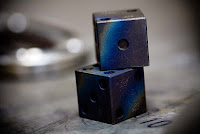A blog for titanium suppliers to discuss current industry issues, news events, the industries we serve and everything important to titanium suppliers, like us.
Friday, September 28, 2012
How is Titanium Made?
In order to make a titanium block or ingot, there is a specific scientific process that must be carefully followed. Titanium is abundant in the crust of the earth, but does not occur by itself. Rather, it is present in rutile, limonite sphene, iron ores, and titanates. Almost seventy years ago, William Kroll developed a method by which titanium could be produced commercially into the form of a titanium block.
The minerals that contain titanium must be charged with a chlorinator in order to make them spongy. At this stage, the substance is referred to as titanium tetrachloride. The chlorinator causes the ores to become porous. After the oxygen is removed from the titanium tetrachloride, a colorless material is left behind. This substance is then distilled. A chemical process is initiated which results in a metallic titanium sponge.
An electrode vacuum arc furnace is needed at this point in order to transform the metallic sponge into a titanium block. Before that can occur, however, the spongy material must be completely crushed and pressed. When the pulverizing stage is complete, the resultant substance is then melted in the vacuum arc furnace at very high temperatures. Titanium block ingots are shaped into various sizes, with some weighing as much as six tons.
After the development of pure titanium for industrial uses, an economic market soon came into being for the prized metal. With more than a hundred industrial uses, titanium is considered both a financial and scientific success. The aerospace industry uses the metal for its strength and low weight. That combination makes it perfect for dozens of high-tech aerospace applications. In the world of ornamental jewelry, titanium has become a very popular metal, leading to a large demand for titanium bracelets, necklaces, and rings. A titanium block can be melted down and uses in smaller quantities, making it usable for any number of other industries as well.
Subscribe to:
Post Comments (Atom)

No comments:
Post a Comment